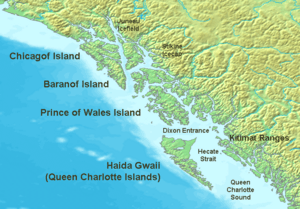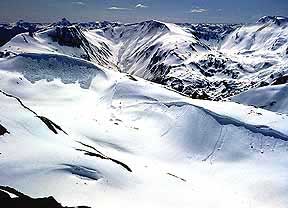Juneau Icefield facts for kids
The Juneau Icefield is a huge area of ice and snow. It's like a giant frozen blanket covering mountains. You can find it just north of Juneau, Alaska. It even stretches across the border into British Columbia, Canada.
This amazing icefield is about 140 kilometers (87 miles) long from north to south. It's also about 75 kilometers (47 miles) wide from east to west. That's a lot of ice! The Juneau Icefield is the starting point for many glaciers. Some famous ones include the Mendenhall Glacier and the Taku Glacier. In total, it has over 40 large valley glaciers and 100 smaller ones.
Many people visit the icefield. They often fly in by helicopter to walk on the deep ice. The ice can be from 240 meters (787 feet) to 1,400 meters (4,593 feet) thick! You can also see huge cracks in the ice called crevasses. Most of the icefield is inside the Tongass National Forest.
Contents
Studying the Juneau Icefield
Scientists have been watching the Juneau Icefield for a long time. Since 1948, the Juneau Icefield Research Program has been studying its glaciers. They want to understand how these massive ice rivers are changing.
Glacier Changes Over Time
Most glaciers on the Juneau Icefield are getting smaller. This means they are retreating, or melting back. Around the year 1700, the icefield was at its biggest. Since then, it has slowly been shrinking.
Let's look at some examples of glaciers that have retreated:
- The Mendenhall Glacier has melted back over 700 meters (0.43 miles) since 1946.
- The Herbert Glacier has retreated about 540 meters (0.34 miles).
- The Eagle Glacier has shrunk by 700 meters (0.43 miles).
- The Gilkey Glacier has retreated a huge 3,500 meters (2.17 miles).
- The Llewellyn Glacier has also retreated about 2,800 meters (1.74 miles).
On the south side of the icefield, other glaciers are also retreating:
- The Norris Glacier has retreated 1,740 meters (1.08 miles).
- The East Twin Glacier has shrunk by 1,100 meters (0.68 miles).
- The West Twin Glacier has retreated 570 meters (0.35 miles).

The Advancing Taku Glacier
The Taku Glacier is special because it's the only one of the 19 main glaciers that is still growing. It's actually getting bigger! This glacier is also one of the deepest ever studied. It's nearly 1,370 meters (4,495 feet) thick.
When John Muir saw the Taku Glacier in 1890, it was already advancing. It also had a large front where ice broke off into the water. By 1963, the glacier had moved forward 5.6 kilometers (3.5 miles).
By 1948, the Taku Fjord (a narrow inlet of the sea) was completely filled with dirt and rocks carried by the glacier. This meant the glacier could no longer break off ice into the water. From 1948 to 1986, the Taku Glacier gained more ice than it lost. This caused it to keep advancing. Since 1987, it has been losing a little more ice, but not enough to stop its advance yet.
Tall Peaks of the Icefield
The Juneau Icefield is home to several impressive mountain peaks. Some of the notable ones include:
- Devils Paw
- Nelles Peak
- Emperor Peak
- The Snow Towers
- Taku Towers
- The Mendenhall Towers
Images for kids
-
Juneau Icefield showing Devils Paw and Nelles Peak






